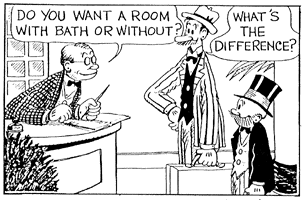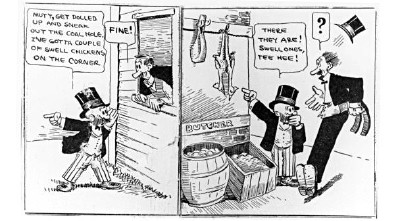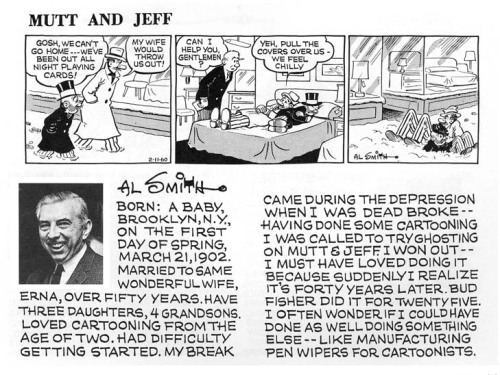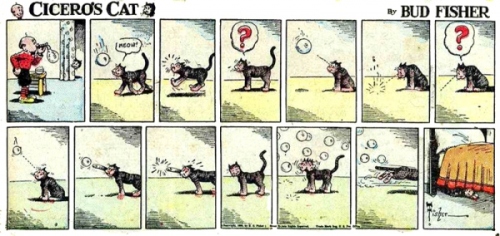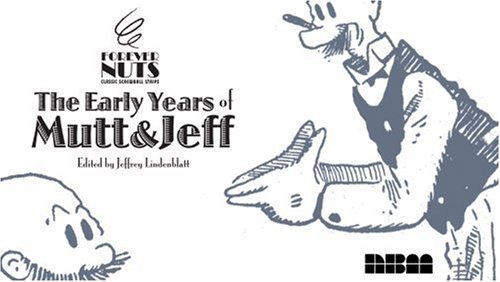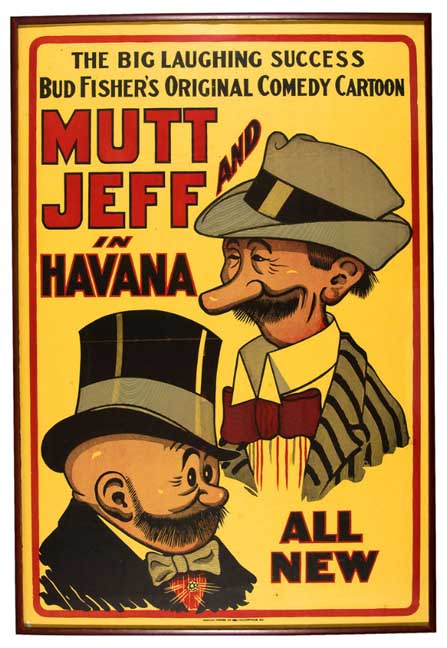Note: This is the fifth in a series of essays written by the current Class of 2012 for Survey of the Drawn Story I, CCS’s comics history class. They are posted here in approximate chronological order of when their chosen subjects—comic strips—were either first published, or in their heyday.
These were class assignments, and should be enjoyed in that context; these are not necessarily indicative of the work the individual artists/writers would do in paid professional venues. This is work assigned in class with a tight deadline, completed while juggling many other class assignments. That said, it is all of high caliber, or we would not be sharing it with you here. Enjoy!
All illustrations and captions in this particular post were incorporated into the original essay, along with captions or comments in brackets [like this], by the Survey I instructor Stephen Bissette, to enhance this public post, as were the author info and “further reading” notes after the essay and author’s footnotes.
________________________________________________
“Mutt and Jeff” and Bud
by Sean Knickerbocker
Mutt and Jeff by Bud Fisher was one of the earliest successful daily comic strips. It is often cited as being the “first comic strip” but many have brought up the notion that Bud Fisher may have gotten the idea from a daily strip called A. Piker Clerk by Clare Briggs, which ran in the Chicago American in 1903, four years before Bud Fisher’s first strip was ever published. It is also worth noting that Mutt & Jeff was originally titled A. Mutt; the original focus of the strip was on horse racing and gambling. Most of the strips followed a strict formula and featured several key tropes.
Some of the more common tropes in a Mutt and Jeff strip include the classic “plotz” as well as characters who had their wrists bent back in such a way where their fingers jutted out to create this feather aesthetic in the hands. The characters were mostly drawn in profile with an occasional three quarters view of a character’s face. Mutt would often jump out of a window. A very common composition was a broken window with Mutt’s feet jutting out of the window frame. Another common final panel for the strip would be Mutt rushing to a bookie window. The gesture for this panel was almost always the same, all four limbs would be sprawled out, the feet wouldn’t be touching the ground, this created a radial design around the character that really expressed movement and excitement very well.

Bud Fisher’s strip was featured as a daily in the sports section of The San Francisco Chronicle being that Mutt and Jeff was one of the earliest comic strips, there wasn’t a comics section in any newspapers at the time. A. Mutt was almost entirely the same joke week after week. Mutt would go to the racetrack and have a hunch for a certain horse, he would bet an enormous amount of money on the race, and then more than likely loose it all. He would then have to go home and apologize to his brutish wife. I think the humor of the strip really derives from observing a character do exactly what has become expected of them to do. The humor comes from familiarity and comfort with the strip, that isn’t to say that the strip could have lasted nearly as long as it did without introducing new conflict.
In March of 1908, the character “Jeff” was introduced. Jeff was a stout character while Mutt was a tall and gangly character, many have said that this duo created a genre of slapstick and vaudeville acts. I do believe it’s true that the strip might have inspired some similar vaudeville acts, but I think it’s worth noting that there is something inherently humorous about juxtaposing a tall, skinny character with a short, fat character. There is a visceral level of humor in seeing these two images collide; it’s a subconscious tension that is created when this sort of thing happens. Other entertainers of the time may have caught on to that idea and incorporated this into their act, but I don’t think audience members do or have ever thought “Oh like Mutt and Jeff” while seeing Laurel and Hardy. As far as character design goes, it’s also a really smart move. Having the two main characters that have exact opposite basic features guarantees that there will never be a confusion as to who is who. I think Clarity is one of the great strengths of this strip.

[Mutt and Jeff by Bud Fisher, circa 1912. Original art scan from http://www.jhalpe.com/media/view/9/page:12%5D
________________
The strip had an unusually wide format, it was originally designed to run the width of a newspaper page and be a single tier. The end result is this really long and narrow strip that almost has a film reel quality to it. I think this narrow format really forces the eye to move at a certain sort of fast pace, almost creating this Zoetrope kind of aesthetic and movement. The “camera” is almost always static, there are no close ups, long shots, high angles, or low angles. I would imagine the reason for this being that cinema was still in it’s infant stage while vaudeville and theater were still more common events. It’s interesting to point out that comics may owe just as much to film as modern film owes to comics. Bud Fisher used backgrounds sparingly and mainly focused on character gesture as well as dialogue. Besides the fact that Bud Fisher didn’t like drawing, I think it also plays to the strength of the medium. Comics can gave the reader an impression of an environment with just a few line strokes, a little bit goes a long way and it’s interesting to see this idea going almost all the way back to the beginning of the modern comic strip. Laziness aside, Fisher was right to use backgrounds sparingly. Not only does the eye focus on the movement of the characters but there is also never any confusion as to where a panel begins or ends. Bud Fisher employs the method of not using gutters, I would imagine he didn’t use gutters mainly because gutters were uncommon for the time but it really lends to the Zoetrope effect I spoke of earlier. Had Fisher been more of a draftsman and rendered more lush environments, the panels would have become muddy and the strip would have lost some clarity.
By 1921, Bud Fisher was making $4,600 a week and then decided to hire ghost artists to draw Mutt and Jeff. Bud wasn’t a big fan of drawing, he was more interested in attending social events and squandering his money. Two of the ghost artists Bud Fisher had hired were Billy Liverpool and Ed Mack. George Herriman and Maurice Sendak had also been assistants for Fisher [generations apart – SRB]. Bud Fisher had assistants as early as 1918 but it wasn’t until 1921 that he had begun to rely on his ghost artist to do entire strips. Billy developed the Sunday topper called Cicero’s Cat in 1934. In 1932 Ed Mack had passed away which opened up a new position in the Mutt and Jeff studio. Al Smith was hired in 1932. Smith had worked on the strip from 1932 up until 1954 with his work signed as Bud Fisher. Fisher had passed away in 1954 and Al Smith began to sign the work as his own, he continued to do so up until his retirement in 1980. The strip continued for two more years and was drawn by George Breisacher. In 1982 the strip was cancelled due to lack of interest and dwindling readership.
Cicero’s Cat was an interesting strip all on it’s own. It was a mostly pantomime comic strip about a cat named Desdemona. Desdemona was Cicero’s pet, Cicero was Mutt’s son. Desdemona was a pretty obscure character but it seems like it was just an excuse for Billy Liverpool to stretch his storyteller legs a little bit. Desdemona has a very similar look to Krazy Kat but isn’t bipedal like Krazy.
It’s a miracle that the strip had lasted as long as it did. The interest in the strip was waning in the late 1940’s but was given a boost in readership in the 50’s when President Eisenhower praised the strip. The strip regained some popularity again in the 70’s due to a nostalgia craze. Mutt and Jeff was syndicated for 73 years. The strip had passed through the hands of many different artists and the strip’s style evolved over time, eventually the strip’s style was more identifiable as Al Smith instead of it’s original creator, Bud Fisher.
 [Mutt and Jeff and Cicero, strip by Al Smith, circa 1963.]
[Mutt and Jeff and Cicero, strip by Al Smith, circa 1963.]
____________________
Bud Fisher was an innovative cartoonist in the ways of business as well. Fisher owned the rights to Mutt and Jeff and he became very wealthy because of it. Early on during the success of his strip, Bud was able to hire ghost artist to do his strips for him. Little is known about Bud’s involvement with the strip at this point in his career, but I think it would be fair to say that much of the praise I give to Bud Fisher is misdirected, in fact, it’s these ghost artists that probably deserve most of the credit. So, not only was Bud a trailblazer for creator rights, he was also ironically a trailblazer for the ongoing exploitation of non business savvy cartoonists all over the world.
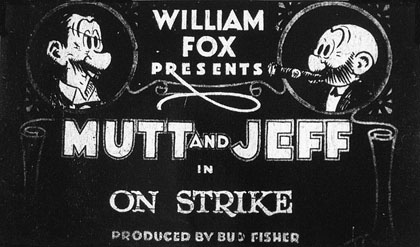
In 1916 Bud Fisher had licensed his strip to be an animated cartoon short. Mutt and Jeff shorts became very popular and over 300 shorts were created of Mutt and Jeff. It was the second longest running movie serial, next to Krazy Kat. In 1918 Mutt and Jeff started running a Sunday strip, this is often cited as the point when Fisher had started having assistants to help with the strip. Between 1918 and 1934 it is a unsure how much involvement Fisher had with the strip, but in 1934 it became well known fact that Fisher was completely finished with the strip and relied wholly on his ghost artists.
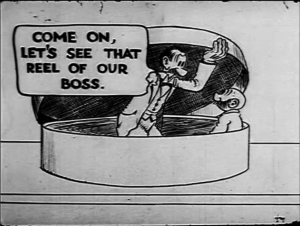
[Frame from the animated cartoon Mutt and Jeff Go On Strike, 1920.]
_________________
Mutt and Jeff had also reprinted in a couple of different comic books. Most notably, Mutt and Jeff had reprinted in what is widely considered to be the “first comic book” which was Famous Funnies #1. Mutt and Jeff had also later reprinted in DC’s All-American Comics.
 Bud Fisher lived very comfortably on the money that his strip had made. In 1915 Bud Fisher had a dispute with William Randolph Hearst and he had decided to move his strip to Wheeler Syndicate. The deal with Wheeler Syndicate gave Bud Fisher 60% of the gross revenue from his strip which was a drastic income increase for Fisher. In 1915 Fisher had earned over $150,000. By the 1920’s Bud was raking in over $250,000 due to tremendous growth in merchandising. Regardless of all the money Fisher had managed to make in his career as a cartoonist, he managed to squander away most of his wealth before he died in 1954.
Bud Fisher lived very comfortably on the money that his strip had made. In 1915 Bud Fisher had a dispute with William Randolph Hearst and he had decided to move his strip to Wheeler Syndicate. The deal with Wheeler Syndicate gave Bud Fisher 60% of the gross revenue from his strip which was a drastic income increase for Fisher. In 1915 Fisher had earned over $150,000. By the 1920’s Bud was raking in over $250,000 due to tremendous growth in merchandising. Regardless of all the money Fisher had managed to make in his career as a cartoonist, he managed to squander away most of his wealth before he died in 1954.
Mutt and Jeff established a cartoon aesthetic early on that has influenced many generations of cartoonists. Two cartoonists that appear to have a strong influence are Robert Crumb and Kevin Huizenga. Crumb employs a lot of these gangly characters with floppy feet and cheap suits as well as the highly stylized faces and gestures. Crumb’s mark making is also very similar to Mutt and Jeff. I’m specifically thinking about the technique that Crumb employs while rendering shading and texture into a characters pants. Both Crumb and Fisher use this contour hatch technique that suggests texture as well as form to the characters. Crumb also uses a lot of characters wearing these old fashioned suits and although it may be Crumb being nostalgic, it does specifically evoke images of Mutt.
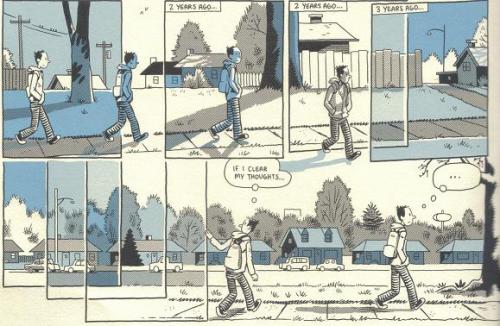 [Kevin Huizenga, Ganges #1 (2006).]
[Kevin Huizenga, Ganges #1 (2006).]
Kevin Huizenga is a more contemporary artist who also seems to employ some of the same tricks that Bud Fisher and his assistants used. The black button eyes, the wispy line weight rendered with nib. Huizenga also uses the contour line hatching in his character’s pants as well. Perhaps it’s a short hand that has stuck with cartoonists over the years.
While I was reading some Mutt and Jeff collections, I couldn’t help but notice an incredible amount of “Black Face” characters in the strips early run. The strip loses a lot of personality when I see these characters in the strip, it feels like another artifact of America’s struggle with bigotry that continues to this day. My argument is, that not only is “Black Face” incredibly offensive, but it’s also just really bad character design and probably even more so, it’s really lazy writing.
Strips without gutters have come back in style recently as well, although I think many contemporary cartoonists have failed to use this method effectively. Some cartoonists have turned the idea on it’s head and created a visual unity in their pages by using intricate backgrounds that repeat in a sequence and create this textile pattern that makes a page feel whole albeit difficult to read. Ron Rege Jr. comes to mind.
[The above essay is ©2010 Sean Knickerbocker, all rights reserved; it is posted with permission.]
________________________________________
About the author/student:
_______
Further reading & resources:
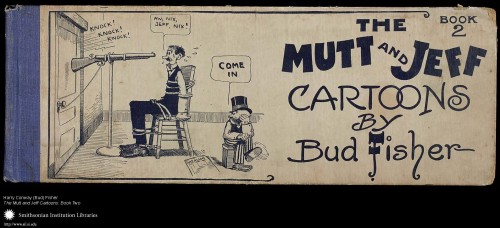
[Cover to The Mutt and Jeff Cartoons: Book Two, 1911, from the Ball Publishing Company. These were among the first American bound comic strip collections ever published, and historically among the first “American comic books” sold. Image from Smithsonian Institute Libraries.]
A number of Mutt and Jeff collections are in the Schulz Library‘s permanent collection.

